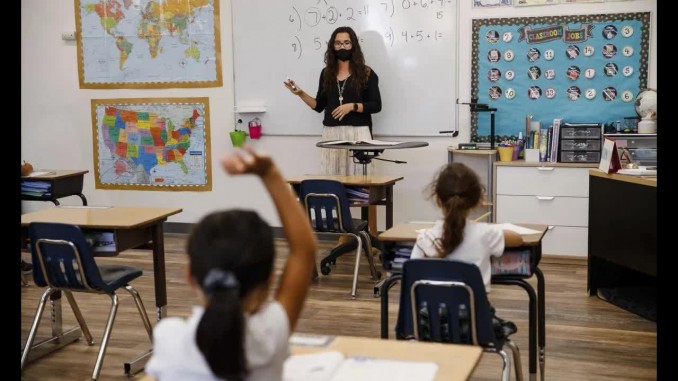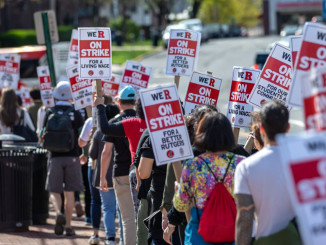
This report is from the Baltimore County Public Schools system, which is suburban and separate from the public schools in the city of Baltimore.
After almost two years stuck in the middle of pandemic politics, teachers and students are still struggling to have their voices heard, and their basic needs met. Everyone from politicians to bureaucrats have voiced their self-important opinions on how the benefits of being in school outweigh the risks the coronavirus pandemic presents. While it is deeply disturbing that anyone questions the importance of keeping people, especially children, safe and healthy, there is another key point missing from the conversation: schools are no longer functioning in a way that is beneficial to students. I cannot speak for all teachers and students in all schools and school districts, but I can share my personal experience. I am a 3rd grade teacher in a Title I elementary school in Baltimore County; what I have seen and experienced is increasingly despicable and utterly unacceptable.
It goes without saying that being in schools at the moment puts students and staff at risk for catching and spreading the virus. Medical experts insist again and again that with proper safety measures the risk is “minimal”; however, these are not educational experts. They fail to consider how difficult it is to ensure that these measures are taken. At my school, we do not have the space to seat students three feet apart: desks are crammed together, lunch tables are full, and our students cannot resist playing and interacting with each other as they normally should. Most students continue to struggle with staying masked, and even for those that do wear masks consistently, they are poorly fitting cloth masks, used over and over without being washed. Additionally, despite recent reports sharing that cloth masks are not effective when it comes to the Omicron variant, faculty were only recently given one KN95 mask each, which might even be considered comical were it not so horrifying. Our custodial team is also understaffed and overworked; furthermore, they are rarely informed of where in the building coronavirus cases are occurring, which prevents them from taking sufficient measures to keep themselves safe, and to thoroughly sanitize those areas.
Obvious public health needs aside, the extreme understaffing in schools is creating an unsafe and chaotic environment. The ratio of students to staff makes it nearly impossible to provide sufficient supervision throughout the building. So many teachers are out sick that our already thinly stretched support staff is deployed to provide coverage in classrooms. This means they are no longer available to fill the roles they typically do, like providing one-on-one support to students with special needs, pulling small groups for interventions, or supervising students in common spaces such as the cafeteria and the hallway.
All of these factors are creating a ripple effect in terms of whether or not students are getting the “benefits” of in-person education that so many of these experts speak of. It is as simple as this: children cannot learn and grow, let alone thrive, in this undeniably toxic environment. Most obviously, students cannot learn if they are not in school, and teachers cannot plan instruction if they do not know how many students they will have on any given day. My classroom has been a revolving door of students out because they are sick or quarantined, and other students joining our class because their teacher is sick or quarantined. Schedules have changed repeatedly due to ever-changing guidelines about how interventions and other pull-out services are allowed to take place, as well as the availability of the staff who provide these services. It is hard to put into words how overwhelming, frustrating, and infuriating these circumstances are. Leadership displays a complete lack of concern for anyone’s wellbeing other than their own, leaving educators with no choice but to set aside our own physical and mental exhaustion to tend to the social and emotional needs of the children as well. My students are feeling scared, confused, and anxious about what is happening now and what will happen next. Some have retreated into their own worlds, some have been acting out, and some have actually developed physical symptoms of anxiety, which are only heightened by the fear that their headaches or tight chests may mean they have COVID-19. These children deserve better.
At a time when teachers, staff, students, and school communities need to stand together in order to advocate for themselves, these groups of stakeholders are becoming increasingly divided among themselves. The tension between those who feel that the current response to the pandemic is an overreaction and those who desire a stronger response becomes more inflamed each day. When we dare to suggest that health and safety be prioritized, we are criticized for being unrealistic, irrational, and selfish for jeopardizing curriculum pacing and “achievement” on standardized tests. In addition, different classifications of staff are constantly pitted against each other: classroom teachers blaming bogged-down resource teachers for providing inadequate support and the understaffed custodial team for not cleaning their rooms sufficiently. The relationship between families in the community and school employees is breaking down completely; many families are losing faith in the school’s ability to keep their children safe and are deciding to keep their students home. This divide only deepens when the majority of teachers and administrators refuse to excuse these students’ absences, putting the families at risk of being labeled a “chronic attendance concern,” essentially being bullied into choosing between their child’s education or their safety. Despite the numerous ways in which our school system is clearly failing, the most concerning is this lack of unity between those of us who should be working towards the same goal: to safely serve students and families in a time of such need.




